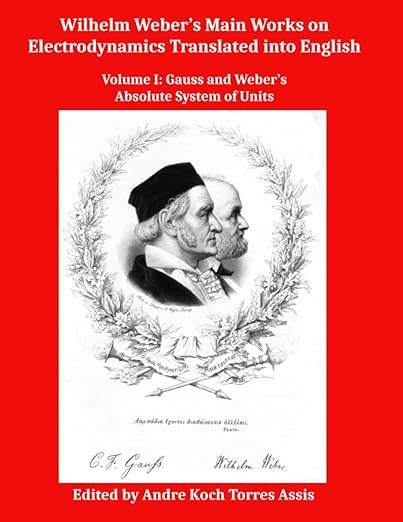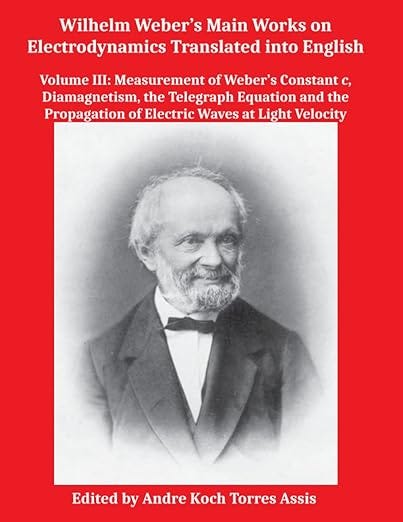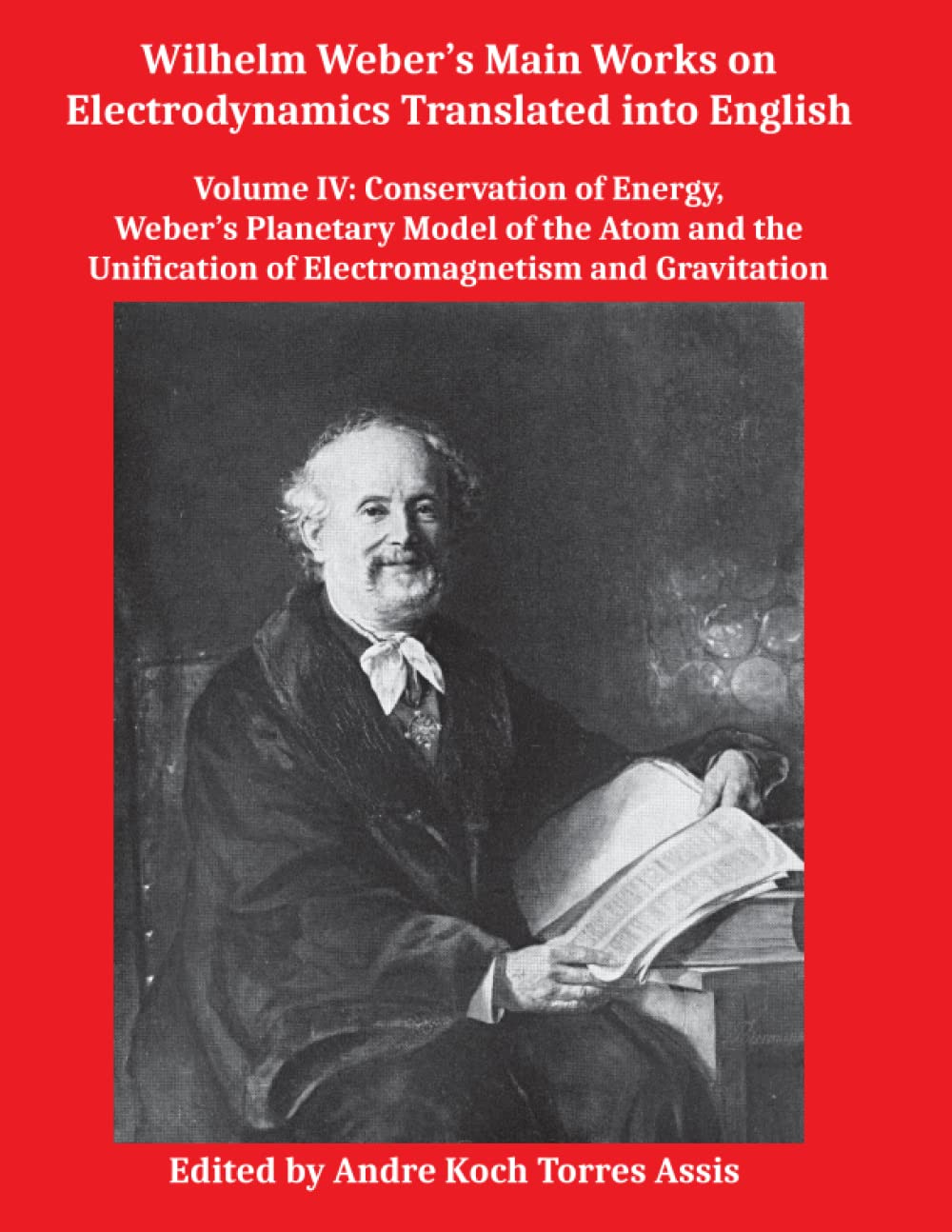As I described in my post English Translations of Coulomb, Ampère and Weber, for many years Prof. André Koch Torres Assis of the University of Campinas in Brazil has been working on making available to the world the works on electricity of Wilhelm Eduard Weber (1804-1891). This project continues, as Prof. Assis is preparing a fifth volume of Weber’s collected works. This post summarizes the current status of this monumental project.
Weber was the last of a continuous line of great physicists who worked explicitly with the principle of action-at-a-distance, also known as actio-in-distans or far-action. In the world of electricity, these included Benjamin Franklin (1706-1790), Joseph Priestley (1733-1804), Charles-Augustin de Coulomb (1736-1806), André-Marie Ampère (1775-1836) and Franz Ernst Neumann (1798-1895).
Peter and Neal Graneau, in their book Newton versus Einstein: How Matter Interacts with Matter1, give a succinct summary of Weber’s work, which was encouraged by Gustav Fechner (1801-1887):
Professor Gustav Fechner argued, at the University of Leipzig, that the electric fluid in Ampere’s current element should consist of discrete charges. The individual charges should obey Coulomb’s far-action law. This would make it possible to express Ampere’s electrodynamic law for two current elements in terms of Coulomb’s electrostatic law for two charged particles. It would unify the sciences of electrostatics and electrodynamics. The urge to unify forces has been with us ever since.
Fechner instructed his assistant Wilhelm Weber (1804-1891) to undertake the task. Weber then assumed that the electricity in a copper wire was made up of positive and negative charges and a small piece of metal surrounding them. The challenge before him was to find a force law for the interaction of two of these current elements. The interaction had to agree with the predicted by Ampere’s law. To this he added the Coulomb forces acting between the two charge pairs. The final formula he called, rather ambitiously, “the universal fundamental law of electric action”.
Since Weber’s law remained faithful to Newtonian far-actions and agreed in other respects with Ampere’s law, it also had to lead to Neumann’s law of induction which was originally derived from Ampere’s law. The universal Weber formula turned out to be a combination of the laws of Coulomb, Ampere, and Neumann…. The new idea in Weber’s electrodynamics was that the magnetic effect of the electric current was due to the motion of electric charges. [pp.120-121]
For more discussion of this topic, have a look at my three posts:
Let us move on to Prof. Assis’s work.
New papers by Prof. Assis commenting on Weber’s work
The first paper, quite short, relates how today’s unit, the ampere, was originally called the weber. The other two papers give detailed presentations of the differences between Weber’s electrodynamics and the quite diverse field-based electrodynamic theories.
2024, A.K.T. Assis. The Weber as an Electrical Unit of Measure:
http://www.ifi.unicamp.br/~assis/The-Weber-as-an-electrical-unit-of-measure.pdf
2024, A.K.T. Assis. The Velocity in Weber’s Electrodynamics Versus the Velocities in Different Field Theories:
http://www.ifi.unicamp.br/~assis/Velocity-in-Weber-and-field-theories.pdf
2024, A.K.T. Assis. Weber’s Electrodynamics Versus Different Field Theories:
http://www.ifi.unicamp.br/~assis/Weber-versus-field-theories.pdf
New translations made available in October 2024
This set of translations is of works written by some of Weber’s colleagues.
1840, C.F. Gauss. Introduction of the paper on General Propositions Relating to Attractive and Repulsive Forces Acting in the Inverse Ratio of the Square of the Distance:
http://www.ifi.unicamp.br/~assis/Gauss-1840.pdf
1892-1894, W. Voigt, Eduard Riecke, Heinrich Weber, F. Merkel and O. Fischer. Prefaces to the Collected Works of Wilhelm Weber:
http://www.ifi.unicamp.br/~assis/Prefaces-Weber-Werke.pdf
1899, W. Voigt. Gauss-Weber Monument:
http://www.ifi.unicamp.br/~assis/1899-Voigt.pdf
Translations made available in February 2024
Some of these translations have been improved and updated since their initial release in February 2024. This set includes several works which were only published posthumously.
1840, Wilhelm Weber. Unipolar Induction:
http://www.ifi.unicamp.br/~assis/Weber-1840-Unipolare-Induktion.pdf
1862, Wilhelm Weber. On Galvanometry:
http://www.ifi.unicamp.br/~assis/1862-Weber-Galvanometrie.pdf
1874, Wilhelm Weber. On the Equivalent of Vis Viva:
http://www.ifi.unicamp.br/~assis/Weber-1874.pdf
1875, Wilhelm Weber. On the Motions of Electricity in Bodies of Molecular Constitution:
http://www.ifi.unicamp.br/~assis/1875-Weber-molekularer-Konstitution.pdf
1892, Eduard Riecke. Memorial speech:
http://www.ifi.unicamp.br/~assis/1892-Riecke.pdf
1893, Heinrich Weber. Wilhelm Weber: A Biographical Sketch:
http://www.ifi.unicamp.br/~assis/1893-Heinrich-Weber.pdf
The following works were only published posthumously in his collected works:
1894, Wilhelm Weber. Comments on the Paper “Investigation into the Electric Arc” by Prof. E. Edlund:
http://www.ifi.unicamp.br/~assis/1894d-Weber-Lichtbogen.pdf
1894, Wilhelm Weber. On Electrothermism:
http://www.ifi.unicamp.br/~assis/1894e-Weber-Elektrothermismus.pdf
1894, W. Weber. On Galvanometry (Excerpt):
http://www.ifi.unicamp.br/~assis/1894f-Weber-Galvanometrie-Auszug.pdf
1894, W. Weber. Electroscopic and Electrodynamic Actions of Free Electricity in Closed Circuits:
http://www.ifi.unicamp.br/~assis/Weber-1894-Electroscopic.pdf
Wilhelm Weber’s Main Works on Electrodynamics Translated into English
Here are the current published four volumes of Weber’s works.
Volume I: Gauss and Weber’s Absolute System of Units
PDF: http://www.ifi.unicamp.br/~assis/Weber-in-English-Vol-1.pdf
Errata: http://www.ifi.unicamp.br/~assis/Errata-Weber-in-English-Vol-1.pdf
Volume II: Weber’s Fundamental Force and the Unification of the Laws of Coulomb, Ampère and Faraday
PDF: http://www.ifi.unicamp.br/~assis/Weber-in-English-Vol-2.pdf
Errata: http://www.ifi.unicamp.br/~assis/Errata-Weber-in-English-Vol-2.pdf
Volume III: Measurement of Weber’s Constant c, Diamagnetism, the Telegraph Equation and the Propagation of Electric Waves at Light Velocity
PDF: http://www.ifi.unicamp.br/~assis/Weber-in-English-Vol-3.pdf
Errata: http://www.ifi.unicamp.br/~assis/Errata-Weber-in-English-Vol-3.pdf
Volume IV: Conservation of Energy, Weber’s Planetary Model of the Atom and the Unification of Electromagnetism and Gravitation
PDF: http://www.ifi.unicamp.br/~assis/Weber-in-English-Vol-4.pdf
Errata: http://www.ifi.unicamp.br/~assis/Errata-Weber-in-English-Vol-4.pdf
I look forward to writing in the future about many of these topics. In the meantime, Happy Reading!
If you wish to donate to support my work, please use the Buy Me a Coffee app.
Peter Graneau and Neal Graneau. Newton versus Einstein: How Matter Interacts with Matter. New York: Carlton Press, 1993.








His work is very exciting